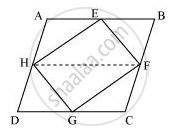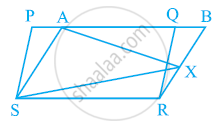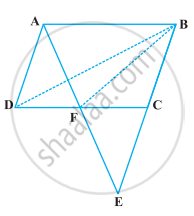Advertisements
Advertisements
Question
If E, F, G and H are respectively the mid-points of the sides of a parallelogram ABCD show that ar (EFGH) = 1/2ar (ABCD)
Solution

Let us join HF.
In parallelogram ABCD,
AD = BC and AD || BC (Opposite sides of a parallelogram are equal and parallel)
AB = CD (Opposite sides of a parallelogram are equal)
⇒ 1/2AD = 1/2BC and AH || BF
⇒ AH = BF and AH || BF (∵ H and F are the mid-points of AD and BC)
Therefore, ABFH is a parallelogram.
Since ΔHEF and parallelogram ABFH are on the same base HF and between the same parallel lines AB and HF,
∴ Area (ΔHEF) = 1/2Area (ABFH) ... (1)
Similarly, it can be proved that
Area (ΔHGF) = 1/2Area (HDCF) ... (2)
On adding equations (1) and (2), we obtain
Area(ΔHEF) + Area(ΔHGF) = 1/2Area (ABFH) + 1/2Area (HDCF)
= 1/2[Area (ABFH) + Area (HDCF)]
⇒ Area(EFGH) = 1/2Area(ABCD)
APPEARS IN
RELATED QUESTIONS
P and Q are any two points lying on the sides DC and AD respectively of a parallelogram ABCD. Show that ar (APB) = ar (BQC).
In the given figure, PQRS and ABRS are parallelograms and X is any point on side BR. Show that
(i) ar (PQRS) = ar (ABRS)
(ii) ar (AXS) = 1/2ar (PQRS)

A farmer was having a field in the form of a parallelogram PQRS. She took any point A on RS and joined it to points P and Q. In how many parts the field is divided? What are the shapes of these parts? The farmer wants to sow wheat and pulses in equal portions of the field separately. How should she do it?
Parallelogram ABCD and rectangle ABEF are on the same base AB and have equal areas. Show that the perimeter of the parallelogram is greater than that of the rectangle.
In the following figure, ABCD is parallelogram and BC is produced to a point Q such that AD = CQ. If AQ intersect DC at P, show that
ar (BPC) = ar (DPQ).
[Hint: Join AC.]

ABCD is a parallelogram, G is the point on AB such that AG = 2 GB, E is a point of DC
such that CE = 2DE and F is the point of BC such that BF = 2FC. Prove that:
(1) ar ( ADEG) = ar (GBCD)
(2) ar (ΔEGB) = `1/6` ar (ABCD)
(3) ar (ΔEFC) = `1/2` ar (ΔEBF)
(4) ar (ΔEBG) = ar (ΔEFC)
(5)ΔFind what portion of the area of parallelogram is the area of EFG.
Two parallelograms are on equal bases and between the same parallels. The ratio of their areas is ______.
ABCD is a parallelogram in which BC is produced to E such that CE = BC (Figure). AE intersects CD at F. If ar (DFB) = 3 cm2, find the area of the parallelogram ABCD.
The diagonals of a parallelogram ABCD intersect at a point O. Through O, a line is drawn to intersect AD at P and BC at Q. Show that PQ divides the parallelogram into two parts of equal area.
In the following figure, ABCD and AEFD are two parallelograms. Prove that ar (PEA) = ar (QFD). [Hint: Join PD].

